Ganga Mata Goswamini was initiated in the line of Gauranga's shakti, Srila Gadadhara Pandit Goswami, by Hari Das Pandit Goswami. Krishnadas Kaviraj Goswami himself has described this Hari Das’s character in his Chaitanya Charitamrita:
The chief servitor of the Govinda Temple was Shri Hari Das Pandit. His qualities and fame are known all over the world; he was gentle, tolerant, peaceful, magnanimous, grave, sweet in his words, and very sober in his endeavors. He was respectful to everyone and worked for the benefit of all. Diplomacy, envy and jealousy were unknown to his heart.The fifty general qualities of Lord Krishna were all present in his body… Ananta Acharya, a disciple of Gadadhara Pandit, was always absorbed in love of Godhead, magnanimous and advanced in all respects. He was a reservoir of all good qualities. No one can estimate how great he was. Pandit Hari Das was his beloved disciple.
(Chaitanya Charitamrita 1.8.54-7, 59-60)
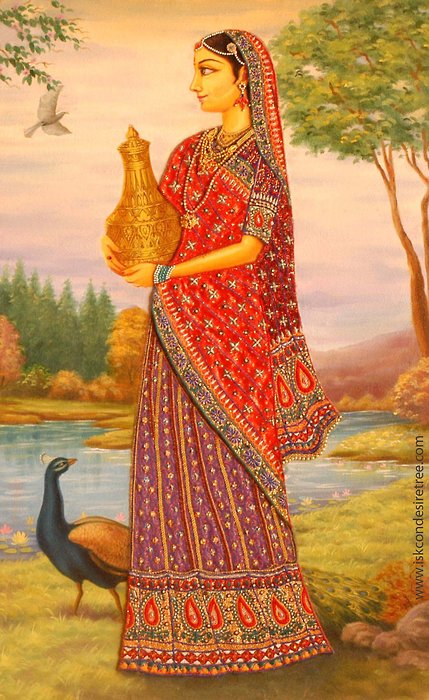
‘Ananta Acharya Goswami was formerly Sudevi-gopi in Vraja (Vrindavan).’ (In the image: Sudevi one of 8 main Gopis).
More is learned about Ganga-mata's holy life from Hari Das Das's Gaudiya Vaishnava Abhidhana and, in more detail, from Sundarananda Vidyavinoda's Shrikshetra, where an elaborate account is given.
Sachi Devi Goes to Live in Vraja
Ganga Mata Goswamini's original name was Sachi Devi. She was born in Puntiya which is in the Rajashahi district of present-day Bangla Desh. Her father was an important zamindar or raja, whose name was Naresha Narayan. From her early childhood, Sachi Devi was indifferent to family life and devoted to Krishna. Her parents saw this and wanted to see her married as soon as possible, but Sachi told them that she refused to accept any mortal as her husband. When she announced her determination to remain unmarried in this way, her parents were troubled but could do nothing to change her mind. When her mother died, Sachi Devi left home and set out on a pilgrimage which led her first to Puri and then to Vrindavan.
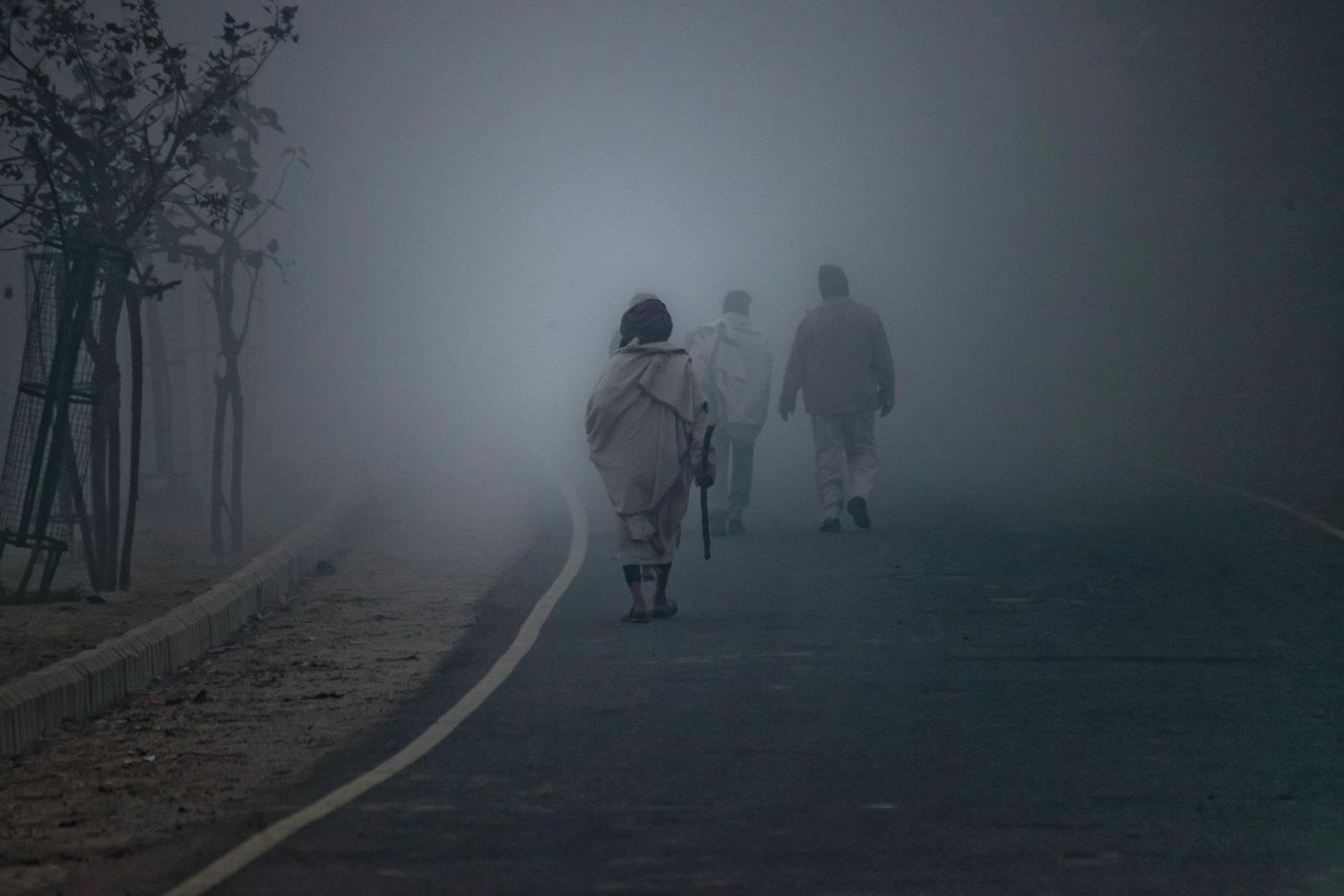
When her mother died, Sachi Devi left home and set out on a pilgrimage which led her first to Puri and then to Vrindavan. (In the image: Brajabasis, Vrindavan).
Upon her arrival in Vrindavan Dhama, she met Hari Das Pandit Goswami and felt as though making contact with him had made her entire pilgrimage worthwhile. She became anxious to take initiation from him, but he hesitated at first because of her wealthy family background. Later, however, when he saw her asceticism and her unswerving determination to engage in pure devotional activity, he gave her initiation in the eighteen-syllabled mantra. This event took place in the Govindaji temple on the Chaitra Shukla Ekadashi.
After having received these blessings from her guru, she began to engage in intense bhajana, subsisting through madhukari, i.e., by begging from door to door for morsels of bread. After a year of this intense devotional activity, she was told by her spiritual master to live in Radha Kund with her spiritually advanced aunt and god-sister, Lakshmipriya, who regularly chanted three lakhs of Names every day. As a part of their regular spiritual practice, the two of them daily circumambulated Govardhana.
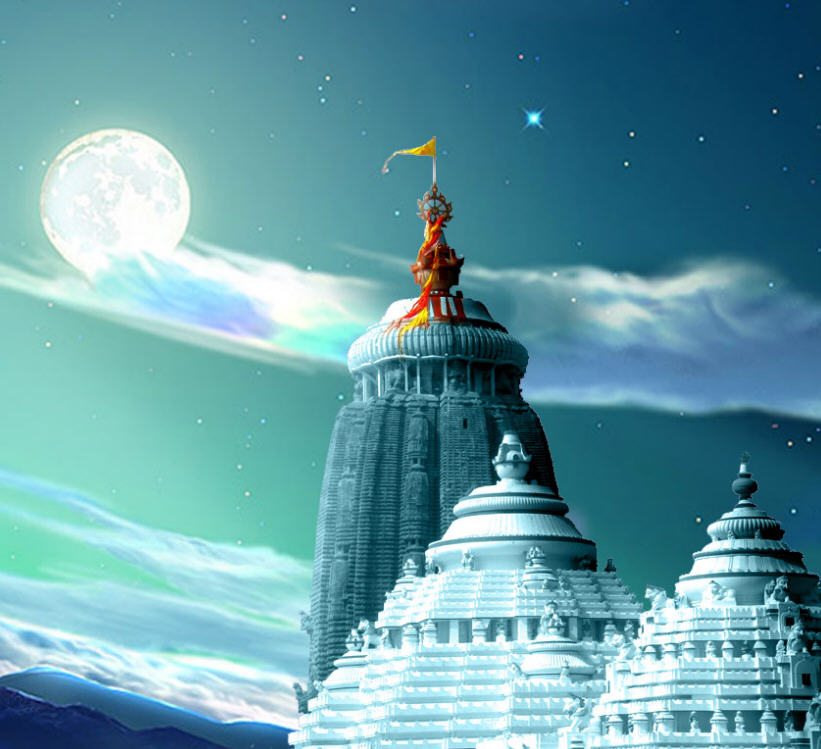
After several years of such practice at Radha Kund, when Sachi had become very advanced in her devotional life, her guru sent her to Purushottam Kshetra... (In the wallpaper: Lord Shri Jagannath's Temple, Puri).
Even while she had lived at home in Puntiya, Sachi Devi had studied the scriptures. In Vrindavan, furthermore, she had thoroughly studied the Bhagavata Purana. In order to salvage Sarvabhauma's residence, she set out to preach. Her explanations of the Bhagavat and her transcendental qualities made such an impression on the public that her discourses soon attracted large audiences. It did not take long before her fame had spread so widely that the king of Orissa himself, Mukunda Deva, came to listen to her Bhagavat lectures. He too became a devoted follower after being impressed by her learning and her devotional qualities.
The Shvetaganga
According to the Utkala-khanda, there was a King Shweta in the Treta Yuga who was a Devotee of Jagannath. He made arrangements for Jagannath's bhoga just as Indradyumna had done. One morning he came to the Temple and saw the offerings which were made by the gods–thousands and thousands of wonderful gifts which were beyond the power of any mortal to present to the Lord. Shweta became disturbed at the insignificance of his own offerings and stood at the Temple door, his head hung in shame. As he was meditating on his own insignificance, he had a vision in which he saw Lakshmi Devi herself taking his food offerings and feeding them to both sets of Jagannath Deities [FN: Besides the main Deities, there is a second set, known as the vijaya-vigraha.] who were eating them with great enthusiasm. The King immediately thought himself consummated by this vision and he continued to serve Jagannath with unflagging enthusiasm. Jagannath eventually granted him the boon of being liberated in a spot which faces Matsya Madhava, halfway between Akshaya Bata and the ocean, which was subsequently named Shweta Madhava in his honor. The tank excavated here was also named Shwetaganga. On the banks of this tank, Deities of Shweta Madhava, Matsya Madhava and the nine planets are still worshiped.

Sweta Ganga.
One night, the king of Orissa, Mukunda Deva, had a dream in which Jagannath Deva appeared to him and told him to give Sachi Devi a tract of land which bordered this Shveta-ganga. The next morning, the King joyfully came to see Sachi Devi and told her about the dream. Though she had no interest in increasing her worldly possessions, Sachi Devi decided to accept the King's gift for the sake of her guru-given mission to improve the condition of Sarvabhauma's house. Prior to that she had had to beg for the wherewithal to serve the deities. Wherever there is true devotion to the Lord, the trouble which one has to take to serve him is not seen as trouble, but rather as an opportunity and a source of joy.
How Sachi Came to be Known as Gangamata
Not long afterward, a miraculous occurrence took place. One Krishna Trayodashi, an opportune moment came for the Maha Varuni Ganges bath. Many people who seek to accumulate pious credits make the trip to the Ganges for this auspicious occasion. Indeed, many of Sachi Devi's friends asked her to accompany them, but she could not abandon her kshetra-sannyasa vows nor her service to the Deities, so she was obliged to plead that it was impossible for her to go.
Even though she did not really want to go, Jagannath Deva Himself made arrangements for her to bathe in the Ganges. That night He appeared to her in a dream and told her to take bath in the Shwetaganga in the middle of the night. Sachi Devi followed His instructions, but as soon as she entered the water, she had a vision of Ganga Devi herself. She was carried away in a strong river current which came from nowhere and suddenly found herself inside the Jagannath Temple. But she continued to see herself bathing in the midst of her friends from Puri. She not only saw the Ganges and all those who were immersed in its waters, but she could hear the joyful noise of the bathing crowds.
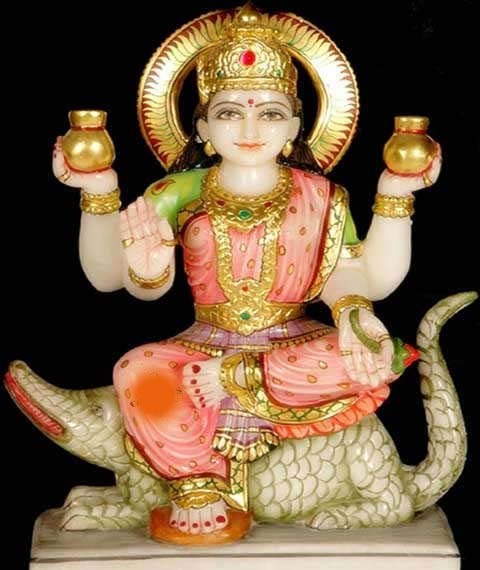
Sachi Devi followed His instructions, but as soon as she entered the water, she had a vision of Ganga Devi herself. (In the image: Deity of Shrimati Ganga Devi).
And she was not the only one. The Temple gatekeepers awakened on hearing this hubbub and called Lord Jagannath's pujaris. They in turn gave a report to the King himself who ordered them to open the Temple doors. When they finally flung the doors open, they saw no one but Sachi Devi standing there alone. Jagannath's pujaris were confused and at first did not know what to do. They assumed that Sachi Devi had broken into the Temple with the intention of robbing the Deities' valuables and that they had caught her red-handed. But by their suspicions they committed an offense to a great Devotee. As a result, they were attacked by various diseases and distresses–so much so that the service to Jagannath was affected.
Jagannath Deva finally appeared to the King again and told him what had really happened. Being influenced by Sachi Devi's pure devotional attitude, Jagannath Himself had made the Ganges flow from His feet to bathe Sachi Devi directly in the currents of His charanamrita. The King and the other servants of the Lord could only be freed from their offenses if they apologized to Sachi Devi and took initiation from her.
King Mukunda Deva went to Sachi Devi with his entourage, the Temple guards and servants. They paid her their prostrated obeisances and begged for her forgiveness. Though the King and all the pujaris, etc., asked her for initiation, she only gave the mantra to the King in obedience to Jagannath's order. The King wanted to give a large amount of land as guru-dakshina, but Sachi Devi refused it. When the King continued to beg for an opportunity to render service, she finally said that every midday he could send two containers of Mahaprasad rice and one of vegetables, a cloth and 160 paisa for the service of the Vaishnavas. From that day onward, Sachi was known as Ganga-mata and Sarvabhauma Bhattacharya's house as Ganga-mata Math and to this day, after the midday offering at the Jagannath Temple, these same items are sent to the Ganga-mata Math.
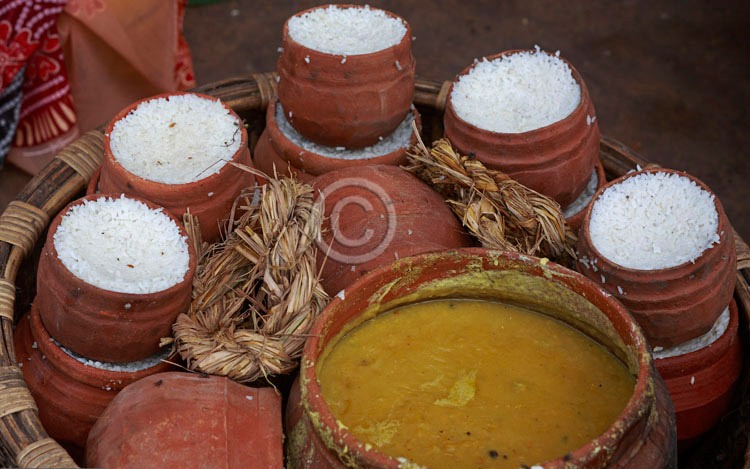
When the King continued to beg for an opportunity to render service, she finally said that every midday he could send two containers of Mahaprasad rice and one of vegetables, a cloth and 160 paisa for the service of the Vaishnavas. (In the image: Maha Prasadam of Lord Shri Jagannath, Puri).
Another of those who were blessed by initiation from Ganga Mata Goswamini was a certain Smarta Brahmin named Mahiratha Sharma from Dhanaïjayapura.
Rasika Raya
There was a Deity of Krishna named Rasika Raya in the house of Chandra Sharma, a resident of Jaipur in Rajasthan. As a result of sevaparadha, offenses in the performance of service to this Deity, this Brahmin had no descendants to continue the family line. Jagannath Deva appeared to him in a dream and told him to bring the Deity to Puri and to give it to Ganga-mata if he wished to be rid of the effects of his offenses. The Brahmin did as he was told and appeared at Ganga-mata's door to offer her the service of Rasika Raya. At first she was not ready to accept, as it was impossible for her to give the kind of royal service which was due such a Deity. Finally, the Brahmin simply hid the Deity amongst the Tulasi bushes and went away. Rasika Raya appeared to Ganga-mata in a dream and told her that He wanted her to accept and serve Him. Having been so ordered, Ganga-mata joyfully took the Deity in and organized a festival in His honor.
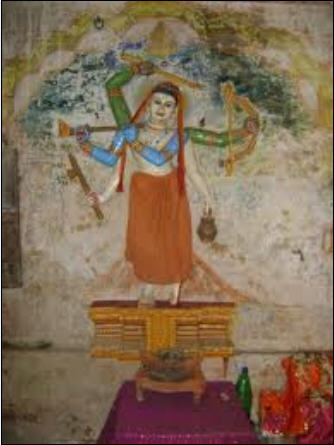
At present there are five pairs of Deities in the Ganga-mata Math: Shri Shri Radha Rasika Raya, Shri Shri Radha Shyamasundar, Shri Shri Radha Madanamohana, Shri Shri Radhavinoda and Shri Shri Radharamana. Other than these, the Damodar Shalagrama-shila of Sarvabhauma Bhattacharya, a dancing figures of Gauranga and a Gopal Deity are also present on the altar there.
According to the information given by the Math, Gangamata was born on the Shukla-dashami of Jyestha in AD 1601 and entered the eternal pastimes in AD 1721. Branches of her Math are found in Jagannath Puri at the Haveli Math and Gopal Math, as well as the Gopal Math in Cuttack district's Tangi village.
Devotees of Krishna may be born in any race, in any caste, or indeed in either sex. They are still to be considered the best of human beings and worshipable by all. There are many examples of women who attained the supreme achievement of pure devotional service to the Lord, such as the wives of the Vedic Brahmins who due to the demands of bhakti ignored the orders of their less-advanced husbands to serve Krishna. In the Kaliyuga, also, as a result of the blessings of Hari Das Thakur, a prostitute was transformed into a renowned Vaishnavi and many great Devotees went to seek audiences from her in order to receive her saintly association.
[Excerpted from “Sri Chaitanya: His Life & Associates” by Srila Bhakti Ballabh Tirtha Maharaj]
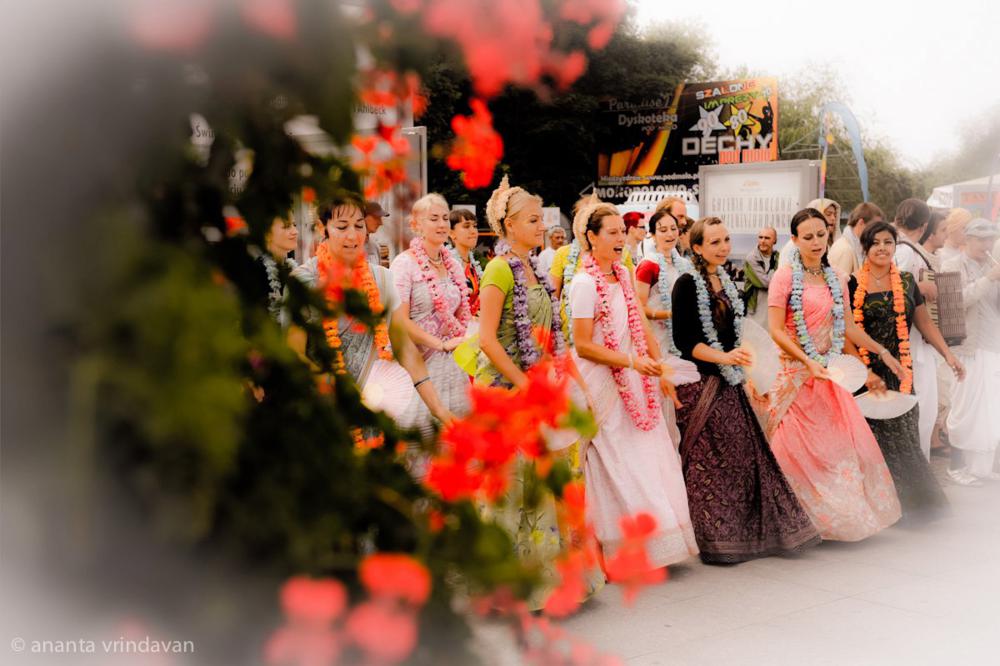
Devotees of Krishna may be born in any race, in any caste, or indeed in either sex. They are still to be considered the best of human beings and worshipable by all. There are many examples of women who attained the supreme achievement of pure devotional service to the Lord, such as the wives of the Vedic Brahmins who due to the demands of bhakti ignored the orders of their less-advanced husbands to serve Krishna. In the Kaliyuga, also, as a result of the blessings of Hari Das Thakur, a prostitute was transformed into a renowned Vaishnavi and many great Devotees went to seek audiences from her in order to receive her saintly association. (In the image: Festival, Poland)